Spyglass Realms - Tumblr Posts

“The first rule of starfaring: do not stare into hyperspace. Never, ever, stare deep into hyperspace; not because of what is there -it is not a separate place from the space we know- but because of what it is. Hyperspace is simply normal space in another direction, one you could not think of if you wanted to, and that in itself is the problem. When a ship flies through hyperspace, it moves by vectors that we can only understand through the comfort of abstract math. Watching it happen before your eyes is a sure way to drive yourself mad. Because the second you stop staring at that void, you will know that for a fleeting moment you understood God, and the only way to get that moment back is to confront the void again.”
— Brother Nicodemos of the Order of Saint Mercurion, describing voidthrall
Voidthrall is the insanity which befalls those who have spent too much time directly observing the reality of hyperspace. Within the shifted resonance state of hyperspace the mind can, to some extent, process the nature of fifth-dimensional reality, as the neural connections made to do so utilize the extra dimension. However, upon the return to the fourth-dimensional resonance state, these connections are inaccessible, leaving only the impression of a greater understanding and the burning itch to know something just beyond reach.
Voidthrall is, without exaggeration, eldritch madness: an obsession with the inherently unfathomable. The afflicted are haunted by echoes of things they cannot imagine without the bone-deep humming of a ship's hyperdrive, unable to make use of this knowledge, yet still plagued by memories of a far greater truth. The longer the afflicted have gazed into the abyss, the more desperate they become to regain their comprehension of the incomprehensible.
The madness is, to date, incurable. The only effective treatment able to soothe those who pathologically seek the unknowable truth is further exposure to hyperspace, until the point where the afflicted become unable to neurologically function in normal space.
Within our current understanding of reality and the multiverse, there is a theoretically infinite number of sophont species that have achieved the Hyperichon stage of advancement and have broken free of their Cycle. Though all have differing origins, these omni-beings are collectively called "Hyperichals," or more commonly "Drifters." Drifters exist outside the limits of the cosmos and can travel between universes at will. They have attained final and complete knowledge of physics, and have total mastery over the workings of reality through post-singularity thaumatech.
They are, in every sense, ultimate.
Individual Drifters no longer retain the biology of their ancestors, having transcended the limits of physical form, and can choose to manifest in whatever way they wish while inside a universe. Since Drifters have an entirely different relationship with time, it is possible (though rare) for a developing civilization to encounter their Hyperichal descendants, though they will likely never realize this unless they are explicitly told so.
In terms of society, there are a few paths a Hyperichon-stage civilization may take after ascendancy. Some believe there is still further to be known, and perform increasingly elaborate and esoteric experiments with the clockwork of reality. Most, however, choose to adopt or create a small, stable cosmos or cosmic network as their new ideal home, called a Haven. They harvest mass from dead universes to build, unlimited, inside their Haven, and maintain its entropy in a similar manner to how we maintain marine tanks or the air cycle in a spacecraft. A rare few Hyperichal civilizations are marauders, but these are the ones who have accidentally attained pseudo-Hyperichal status before they were ready and almost always destroy themselves in due time. True Drifters have no qualms with each other; they live in a post-scarcity eternity, where everything is infinite and forever.
It's the 8th anniversary of Sphaera today! I created the original map of the world that became Sphaera on 4/24/2015. In celebration of this worldiversary, here's the project's overview article on WorldAnvil!

God is real and I watched him pick his nose last week

Art by @wildegeist!
While most of the worlds I build explicitly have no gods –at best, powerful god-like entities– there is one where the opposite is true: Crundle.
Tarsweh, the creator-god of the Crundlean realm, is verifiably and undisputedly real. He is visible in the sky at all times, no matter where you are on the planet. But the funniest thing is that he doesn't actually fucking do anything.
Without even intending to, I have created the purest inversion of how most people treat capital-G God IRL:
instead of "we don't have any proof that he exists but oooh here's a bunch of miraculous inexplicable things he's done, probably"
Crundle has "yeah he's there, everyone can see him, but we have no evidence at all that he does, has done, or ever will do anything except stare blankly at the world and sometimes stick a finger up his holy nostril."
In a galaxy of millions of cultures stemming from over a hundred sapient species, recreation is a vastly diverse pool of activities! Quintillions of beings across the stars spend their free time having fun in all manner of ways. Here's a brief collection of examples.
Most cultures have some form of recreational gambling, but Zaarcs are pretty fond of card games, and that fondness proved infectious to the wider galaxy. Their card set has six suites: suns, stars, moons, bolts, flames, and waves. Games played with this set include Sol-Hai (a bit like Alien Go Fish), Cerec, and Horizon Folly.
The galaxy is suffused with the Etherlink digital network and virtual games abound, but that doesn't make the real world any less appealing! Physical sports are alive and well in the modern galaxy, and particularly popular games include:
nulloball - dodgeball in zero-gravity
netrush - something vaguely like a cross between soccer, full-contact rugby, and trampoline sports
zem'hurut - a team-based martial arts competition from the Haalla Supercluster, sort of like lacrosse but with kung fu
chalban - a sport invented by the centauroid Pelmens of Dura which involves jousting and utilizes a (dull) javelin as the thrown scoring object
And of course, it wouldn't be a futuristic interstellar super-civilization without stupidly dangerous high-speed spacecraft racing! Racing is very popular among pilots and spectators alike; enough to have generated a pan-galactic aerospace expo that occurs every four cycles: the Galactic Pilot Convention. Zak is actually a minor celebrity in that circuit, and has a few awards from past conventions!
I'm in the process of giving the Diaspora star map a much-needed aesthetic overhaul. It's turning out pretty well so far! Here's the first stage: up to 10 ly from Sol.
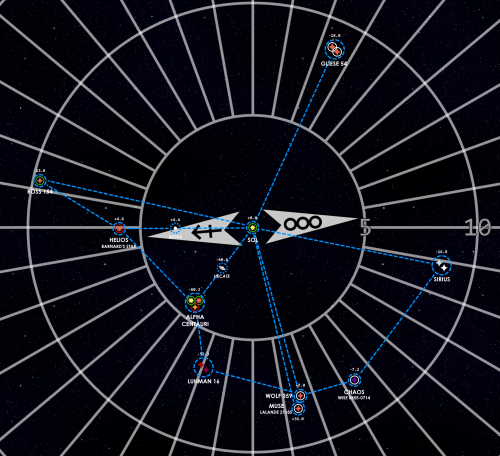
Some notes:
all stars (four and eight points) signify an individual star, colored according to its spectral type.
eight-pointed stars are the homesuns of sapient species.
stars with rings have at least one planet. green rings indicate native life present; red rings indicate prior terraformation by the extinct Hemeran civilization.
the two other markers, one white dot and one white dot with an angled ring, indicate rogue interstellar planets.
the map is arranged by right ascension (celestial X coordinate) and distance, so the +/- number above each system is its declination (celestial Y coordinate).
the arrows at the center indicate the directions of the galactic core and rim, using the symbols of Sagittarius and Orion, respectively (although this map is aligned to right ascension which means the plane we're viewing is actually almost perpendicular to the galactic disk)
Second stage complete! Now featuring all systems out to 15 ly from Sol.
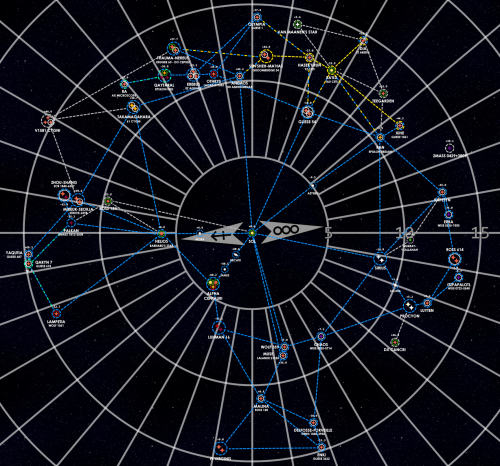
Additional notes:
The green-colored rogue planet, Murray-Callahan, is the only unbound interstellar object (UIO) known to harbor life.
The blue links in the network are systems and routes that are claimed by the United Nations of Humanity.
The yellow links in the network are systems and routes that are claimed by the Ra'na InterGlobal Council.
The turquoise links in the network are systems and routes that are claimed by the Worldtribe.
Grey links are neutral and under jurisdiction of the United Spacefaring Sophonts Coalition, usually either crucial hub systems or systems with carefully managed native life.
I'm in the process of giving the Diaspora star map a much-needed aesthetic overhaul. It's turning out pretty well so far! Here's the first stage: up to 10 ly from Sol.

Some notes:
all stars (four and eight points) signify an individual star, colored according to its spectral type.
eight-pointed stars are the homesuns of sapient species.
stars with rings have at least one planet. green rings indicate native life present; red rings indicate prior terraformation by the extinct Hemeran civilization.
the two other markers, one white dot and one white dot with an angled ring, indicate rogue interstellar planets.
the map is arranged by right ascension (celestial X coordinate) and distance, so the +/- number above each system is its declination (celestial Y coordinate).
the arrows at the center indicate the directions of the galactic core and rim, using the symbols of Sagittarius and Orion, respectively (although this map is aligned to right ascension which means the plane we're viewing is actually almost perpendicular to the galactic disk)
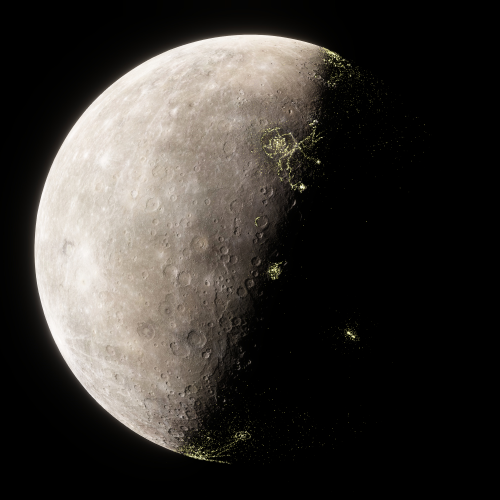

Mercury is a small, airless world in the deep inner Sol system, the closest planet to its sun and consequently a world of thermal extremes. Its solar day is over 1400 metric hours long, meaning that any point of the surface is exposed to sunlight for 700 hours or more. Because of this Mercury isn't an especially populated world –just under twenty million souls live and work almost entirely beneath its rocky crust– but the surface facilities shine brightly because there is no atmosphere to dull their light.
Much of Mercury’s 19.4 million inhabitants are concentrated in the capital city of Lóng Cháo, embedded into and under the surface of Rachmaninoff Crater (seen here on the terminator line, in the northern hemisphere). Its orbital space, however, is busier, serving as a hub for the ore traders hauling raw materials from one side of the solar system to the other.
Mercury is an autonomous territory of the United Sol System, as part of the Inner System Territories. Its flag, an inverted monochrome depiction of its penumbra, is shown below the main image.
more worldbuilding stuff! photobash of a future human-inhabited Mercury, plus its flag, created for my hard science fiction setting Diaspora. done using assets from Space Engine.
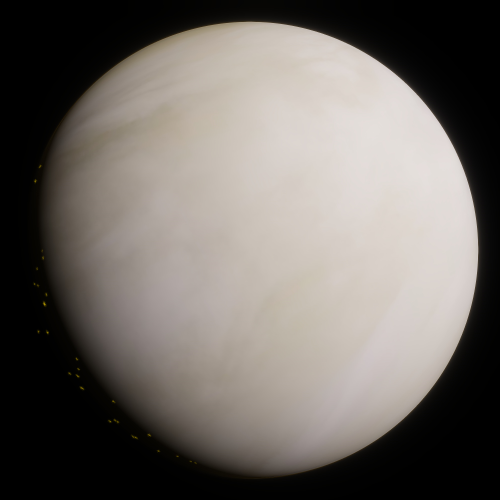

Venus is the second planet in the Sol system, an Earth-sized rocky world with a dense, hot CO2 atmosphere and aggressively volcanic surface. The only habitable zone of Venus is a relatively thin layer of atmosphere some fifty kilometers above the surface, where the temperature and pressure closely resemble conditions at sea level on Earth.
Because of this air layer, the skies of Venus are swarming with aerostat habitats to support its 25.4 million inhabitants (seen here as a scattering of hazy glowing dots in the thin crescent of twilight). The largest aerostat is the capital city of Najam Alsabah, nestled in the lower stratosphere. One of the key drivers of Venus’ growing population is its wealth: the territory has become quite prosperous over the last several centuries due to the harvest and export of valuable, rare chemicals such as nitrogen, sulfur, and phosphorous.
Venus is an autonomous territory of the United Sol System, as part of the Inner System Territories. Its flag, a bicolor high-contrast depiction of its vast atmospheric cloud waves, is shown below the main image.
at last, some more worldbuilding stuff! photobash of a future human-inhabited Venus, plus its flag, created for my hard science fiction setting Diaspora. done using assets from Space Engine.
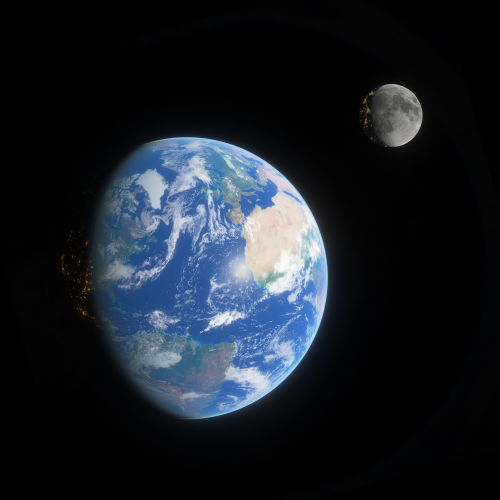

The planet Earth is the third planet in the Sol system, a vibrant terran world with a diverse biosphere recovering from a near-miss ecological collapse. It has six major landmasses surrounded by vast oceans of liquid water, and its atmosphere is a comfortable nitrogen-oxygen blend at a pressure that is dense enough to protect but not enough to crush. It also has one relatively large, airless, rocky moon, called Luna (or simply "the Moon.")
Earth is also home to an indigenous sophont species: humans, one of the founding members of the Coalition of Spacefaring Civilizations. Because of its deep pre-spaceflight cultural history, it is one of a minority of worlds divided into nations, hence its primary governing body being the United Nations of Earth -the ancestor to most of humankind's modern administrative structure. Being Earth's only natural moon, Luna was the site of humans' first forays into extraterrestrial exploration, and today is an industrial powerhouse under the flag of the UN Autonomous Territory of Luna. The Earth-Moon Union (EMU, for short; top flag) is composed of the United Nations of Earth (bottom left flag) and the Autonomous Territory of Luna (bottom right flag), with its primary seat being Midway Station located at the L-1 gravitational stability keyhole between Earth and Luna.
As the birthplace of the human species, the Earth is the most populous and powerful asteropolitical entity in the Sol system, and quite possibly in the entire United Nations of Humanity. Earth itself has a population of just over 8 billion, which has stayed relatively stable since the 21st century. Together with the Moon’s 240 million inhabitants, the total population of the EMU is about 8.4 billion, almost four times that of the next largest entity in the system (Mars).
While Luna’s primary industry in the modern day is mining, Earth’s rich cultural and biological history makes it a tourist destination renowned across known space, though it has stringent biosecurity. For many, it is even a spiritual experience, some going so far as to make it their life’s goal to retire on Earth and connect with the home of their ancestors. Centuries of ecological engineering and conservation have managed to avert the effects of early human industry, restoring the world to a natural balance and even reviving many species driven extinct by human error. Today, one can watch herds of mammoth roam the Siberian tundra, visit dodo birds on Mauritius, or experience the return of Australia’s Great Barrier Reef. 30th century Earth is a good place to be, and humanity is collectively proud of their home: the cradle of the Diaspora.
hey look, more art! been a hot minute. photobash of a future Earth and its well-settled Moon, plus their flags, created for my hard science fiction setting Astra Planeta. done using assets from Space Engine.
STAGE THREE, EVERYBODY GIVE IT UP FOR STAGE 3
This is where things get COMPLICATED. Damn thing looks like an eldritch horror but I'm PROUD of it. Two more phases to go.

Additional notes:
Added perpendicular dashes in a network line to show a connection that bypasses a given marker(s), due to the limits of 3D space being represented in 2D. Hopefully this is intuitive.
The orange links in the network are systems and routes claimed by the Rimor Corporate Conglomerate.
The darker green links in the network are systems and routes claimed by the Xib Zjhar. Their systems do not link to any others because they are an isolationist culture.
The purple links in the network are systems and routes claimed by the Allied Tribes of Calypso. Very few systems are under their jurisdiction due to their inexperience with spaceflight and the rarity of their required environmental conditions.
Yeah, I know I forgot Furuhjelm 46. I'll fix it later. And yeah, I know Xi Bootis is well beyond the 20ly-boundary. I put it there bc I had the G/K binary marker copied and was saving myself some labor later.
LP 816-60 should have a Worldtribe designation, probably a Qaryn number. I'll fix it later.
Multiple brown dwarf systems are potential candidates for Calypsian habitation, but I have some stuff to figure out about them first.
I'm in the process of giving the Diaspora star map a much-needed aesthetic overhaul. It's turning out pretty well so far! Here's the first stage: up to 10 ly from Sol.

Some notes:
all stars (four and eight points) signify an individual star, colored according to its spectral type.
eight-pointed stars are the homesuns of sapient species.
stars with rings have at least one planet. green rings indicate native life present; red rings indicate prior terraformation by the extinct Hemeran civilization.
the two other markers, one white dot and one white dot with an angled ring, indicate rogue interstellar planets.
the map is arranged by right ascension (celestial X coordinate) and distance, so the +/- number above each system is its declination (celestial Y coordinate).
the arrows at the center indicate the directions of the galactic core and rim, using the symbols of Sagittarius and Orion, respectively (although this map is aligned to right ascension which means the plane we're viewing is actually almost perpendicular to the galactic disk)
hey, big news!! the worldbuilding project formerly called the Diaspora [DSP] is now officially being renamed to Astra Planeta [ASP]!! The tags and world overview post have been changed to reflect this already, but it would be too much of a pain to go back and edit every instance of the old name so here's the explanation. :3
The Αστρα Πλανητα were what the ancient Greeks called the five "wandering stars" in the night sky; the English word "planet" arises from the ancient Greek word for "wandering". The name in context of the setting recalls our status as interstellar explorers, restlessly pursuing the edges of the universe, and also connects to our long history of stargazing.
other pros to this new name:
unique as a setting title, as far as at least three search engines have shown! the only references I could find to this specific term are academic, talking about the actual astra planeta
coincidentally references one of the very first subprojects I worked on after the setting's metamorphosis from Ra'na into Diaspora: a fictional history book called "Wandering the Sky"
Well, that's the final nail: all published material for Starhopper Radio is officially inaccurate to Astra Planeta canon. I moved some last things around to make the puzzle pieces fit better and now every place and date mentioned in the four extant episodes of SR (except the Apollo 11 moon landing) are incorrect.
I figured this would happen eventually, which is why I stopped producing episodes. I'll get back to it one day when canon is stable.
Exploration Day
October 3rd is a significant date in Astra Planeta, due to a series of important historical coincidences:
> 10/03/1957 was the day Sputnik 1 was launched into orbit
> 10/03/2018 was the day humans first set foot on Mars
> 10/03/2036 was the day the Ariadne probe discovered unequivocal evidence of complex life in the subglacial ocean of Europa
> 10/03/2145 was the day the MiMUS probe returned the first images of the alien ruins on the Uranian moon Portia (although the investigation took more than a week to conclude on the alien nature of said ruins)
> 10/03/2191 was the day humans first set foot on a world in another solar system: Calypso, a life-bearing moon in the Proxima Centauri system
Exploration Day, therefore, is a celebration of peaceful and responsible cosmic curiosity that carries on the spirit of the people who expand our horizons. People of all walks of life, from all inhabited worlds across space, celebrate October 3 as the holiday of human wanderlust and the joy of understanding; hopeful that we will forevermore venture forth with humility and compassion, and never lose our way again.
Happy Exploration Day!
Pocket Guide to Intercosmic Travel
So, you've just become aware of the multiverse! Eternity, reality, omnicosm– no matter what you call the largest unit of existence that supersedes mortal notions of time and space, you're going to need to reframe your perspective on it. Here's a handy guide to get you started!
Multiversal Structure
The multiverse is composed of two aspects: universes (aka cosmoses or yggdrasili) and nullspace (aka aether or ginnungagap).
Universes
A natural-born universe, also called a “cosmos” or “yggdrasil,” originates as a single infinite point containing all of the spacetime and mass-energy of its existence in compressed form. This is called a “seed singularity” or just a “seedling”: a singularity of infinite potential. This seedling sprouts infinitely-branching possible spacetimes after initial expansion; any possible split fork moment in probability down to the quantum level creates a new timeline (or “branch”) extending off of the previous one.
Once a universe has grown out its branches all the way to the very end, after entropy has rendered every single worldline into a uniform smear of cold, stable, subatomic matter, gravitational force is absolutely uniform across the entirety of spacetime. This causes the ends of the branches to collapse into new seed singularities and pinch off, drifting free through nullspace until accumulated exposure to the primordial background energy triggers germination through quantum flux. Because time and causality don't apply outside the spacetime of a universe, the reproductive cycles of universes form an infinite chain of reincarnation.
Pseudocosms
A pseudocosm or pseudoverse, colloquially called a “Haven,” is an artificial cosmos created by one or more godlike hyperichal beings. Usually created by heavily altering a harvested seedling, these constructs often defy standard universal structure, existing in stable localized monocausality with deliberately maintained (cyclical) entropy. They exist effectively as sandboxes for the transcendent hyperichals, allowing them to “play god.”
Nullspace
Nullspace, also called the “aether” or “ginnungagap,” is the “space” in which universes exist, though it is impossible to actually conceptualize as a “space” because it doesn't technically exist. Nullspace is both infinite and imaginary, meaning that there is no relative position in it: every cosmos exists both adjacent to and far apart from each other. Nullspace is uniformly suffused with a unique form of energy, called primordial or aethereal energy, which has no carrier particle and contains infinite potential. This infinite raw energy is thought to be the driving force of the quantum vacuum fluctuations in each causal universe, which also serves to trigger singularity expansion in newborn universes.
Intercosmic Travel
When an object native to a cosmos exits its branch without a protective pocket of spacetime, its waveform collapses. An object removed from its original spacetime becomes detached from its native past, future, and alternate instances (its “worldline”), inhabiting a new causal lineage tethered to itself alone. When sapient beings accomplish this (except in the case of hyperichal transcendence), their new causal lineage is often called a “personal timeline” or, more succinctly, “lifeline.” Material beings who are capable of intercosmic travel are called, among other things: “Travellers,” “aethernauts,” or “planeswalkers.” Non-material, transcendent beings who have converted themselves to a causality-free post-cosmic format and, effectively, achieved “godhood” are called hyperichals, or simply “Drifters.”
Hyperichals
Hyperichals are sapient beings who have converted themselves into stable, complex superstring resonance patterns which exist outside the spatiotemporal limits of their cosmos of origin. They have attained final and complete knowledge of physics, and have total mastery over the workings of reality through post-singularity thaumatech. This allows them to not only travel freely across the multiverse, but control the structure of reality itself. It is the most literal form of godhood there is; in fact, most universes with known gods are actually the subjects of hyperichal influence.
Cosmography
The best system yet conceived for cartographing specific instants in a given universe is that of the Cosmos Index in the Gardener's Eternal Archive; available in physical, metaphysical, digital, gravirtual, hyperwave, psychonic, superstring compact resonance, and other formats for convenience. Its method is quite similar to that of the hypothetical Library of Babel: a primary starting point followed by a long string of increasingly specific divergence points in time and space. The end result is that the full address of any point in the multiverse is a large paragraph of absolutely eye-watering numerical gibberish, punctuated by the occasional semicolon. Fortunately, the index includes a spot for a cosmic prime-branch's colloquial names as well, making things easier for all Travellers. This is also useful for including pseudocosms, such as the notorious realm of “Crundle.”
A parallel to this project is the Traveller Index, which functions essentially as a “multiverse phonebook” - it is a compendium of all known beings who are capable of intercosmic travel. Each entry consists of a being’s preferred identity, cosmos and specific instant of origin, and a superstring code –much like a hyperichal consciousness, a “superstring code” is a sub-quantum resonance pattern unique to each individual Traveller’s “lifeline.” There are technically infinite entries in the full Index, but its natural form exists in a superimposed state unbound by time or space. When it is localized for active reference, it can have anywhere from a dozen entries to trillions of entries.
Major UNH Members
A brief list of the largest (by population) members of the interstellar United Nations of Humanity in the Astra Planeta canon.
United Sol System

System: Sol Seat: Gaea Station, Earth orbit Population: 12.78 billion
Centauri Republic

System: Alpha Centauri Seat: Chiron Station, Fortuna-Concordia circumbinary orbit Population: 18.45 billion
New Nations of Helios

System: Helios (Barnard's Star) Seat: Astraeus Station, Hemeran orbit Population: 9.56 billion
Dogstar Federation

Systems: Sirius, Procyon, Luyten's Star, Kapetyn's Star, Ross 614, Lucina, Itzpapalotl, Erra Seat: Remus Station, Procyon Prime orbit Population: 11.54 billion
Winds of Anemos

System: Anemos (HH Andromedae) Seat: Port Magellan, Hippotes, Tempest Belt Population: 3.4 billion
Pantheon Alliance

Systems: Olympia (AX Microscopii), Othrys (Lacaille 9352), Erebus (EZ Aquarii) Seat: None Population: 22.6 billion
Takamagahara Unitary Republic

System: Takamagahara (61 Cygni) Seat: Tengokyokai Station, Inari orbit Population: 7.08 billion
Reblogging this in honor of Astra Planeta's ninth anniversary!
I'm starting to come back around to Astra Planeta in a really substantial way, and if you don't mind I'm gonna think out loud here for a little.
Astra Planeta is categorically hard science fiction, in that it adheres to the definition of the genre: the scientific and technological elements presented in the world's canon are within the realm of what we consider possible with our current collective knowledge of science and technology. However, ASP breaks the mold of hard science fiction by being optimistic in three key ways: technological, social, and existential.
Astra Planeta is technologically optimistic in assuming that any engineering problem standing between us and efficient interstellar travel can be solved. According to the canon timeline, fusion power is relatively commonplace by the mid-21st century, and by the start of the 22nd century humanity have developed a proper torchship. Human health issues stemming from long-term space travel are easily resolved with high-power magnetic shielding and centripetal pseudo-gravity, plus a touch of good ol' genetic therapy to keep the body strong and healthy. Wormhole technology is developed for instantaneous communication by the 22nd century, and by the end of the 23rd century humans have begun to unlock faster-than-light travel by engineering our first warp drive. In the few centuries between the first spaceflight and the first extrasolar mission, humans figure out (non-cryogenic) stasis, perfect closed-system environment maintenance, and build AI with thought patterns so similar to people they might as well have souls. We have our cake and eat it too. All of this is within the scope of "scientifically possible," though certain parts are hotly debated in academic circle. But the rapidity with which we achieve these milestones is shamelessly optimistic. It has to be, or else the premise of the setting falls apart.
Astra Planeta is socially optimistic in assuming that humanity, as a global entity, can overcome -or at least overlook- the cultural divisions which set people apart and cooperate as a singular civilization. I've talked about this extensively elsewhere, but one of the keystones of the project is the thorough demilitarization of planet Earth and all her nations. By the end of the 21st century, "war" is a word that has passed out of the news cycle and into history books. It took some doing, sure, but in this reality humankind was faced with the imminent degradation of their home planet and collectively decided that there were bigger fish to fry than each other. Complex issues left unresolved for generations were gradually untangled and sorted out, with a lot of patience and a bit of nihilism. Implanting a profound sense of human fragility into the global consciousness helped give them all a sense of perspective. Nothing can last forever. There's no point to being the best. The only solace we have in the vast and indifferent universe is each other, and isn't it important, then, to make life better for ourselves and everyone around us? This is how we finally reached the stars: together. Upon making contact with other sapient beings, we carried this lesson with us and did our best to befriend them. Astra Planeta operates on the principle that the Great Filter is the shedding of tribalism, and assumes that the human species is smart -and kind- enough to achieve this.
Astra Planeta is existentially optimistic in assuming that life is not rare in the universe at large, and thus there are not only dozens of worlds nearby which harbor biospheres, but there are also several advanced, peaceable civilizations in close proximity -both in space and time. Statistically, the number of civilizations in the setting implies a maddeningly large number of contemporary civilizations present in the galaxy at large, which does not line up with current evidence whatsoever. It breaks from expectation not only with first contact happening at all, not only with first contact going relatively well, but with multiple first contact events all going relatively well. It assumes that mutually intelligible communication is possible for all contact events, and that most contemporary civilizations share our basic morals and aspirations in some sense. All of these elements are, given our current hypotheses on alien life, immensely improbable –but not impossible. Granted, this isn't baseless contrivance purely to make the setting interesting; there is underlying justification for most of the more conspicuous contrivances. For example: taking our planet Earth's biosphere as a point of reference, it seems likely that if complex life exists anywhere in the universe for a long enough span of time, it will evolve some degree of sapience. Odds seem to be very slim that any of these hypothetical sophonts would develop advanced technology, and even less to the point of globalization and multi-planetary society. But the fact remains that they could, and in a universe where life is far more abundant than expected, a small fraction of biospheres generating spacefaring civilizations still makes for quite a few spacefaring civilizations. ASP does not posit that the clockwork of reality has a conscience and is merciful –it is often explicit in stating that the universe simply is what it is. What it does posit is that, however statistically improbable this may seem given our current level of understanding, the cosmos is practically teeming with life. Without this concession to "realism," the premise of the setting falls apart completely.
All three of these assumptions are crucial to the Astra Planeta canon, as their interplay forms the diverse interstellar near-utopia that is the United Spacefaring Sophonts Coalition –which, of course, the setting centers on. As mentioned, ASP does not assume that the forces of nature are kind; the randomly catastrophic nature of the universe is the prime source of narrative conflict here. But Astra Planeta stands as my monument to hope: a world that is better, but still interesting.
Thank you for coming to my TED Talk :)
Sooo the canon has changed a bit since the last WIP map was posted, and consequently so has the map itself! Notably: the setting is now called Astra Planeta. I'm still working on the sheet that I use to keep track of everything, so little progress has been made on Stage 4, but I'll get there soon.

Changes:
The map got flipped. I realized I'd made an egregious error: right ascension is actually measured west to east, which means counterclockwise if viewed from the north celestial pole. Oops!
I've changed some names (and, while not visible on the map, some system compositions). For those of you wondering why the star formerly labeled Tamanuitera is now Radegast, fear not: I'm keeping Tamanuitera in my pocket for a higher-mass star so I can plausibly give the system more planets with a greater variety! Same goes for the other systems whose names have been changed.
Brown dwarfs are no longer good candidates for Calypsian habitation, now that I've nailed down the basic mechanics of their ecosystem. They're more partial to lower-mass stars, sure, but not infrared-only substars. Brown dwarf systems remain useful only for waystations and some industry.
Added a handful more rogue planets, mostly to serve as waystations between certain major stars with slightly-greater-than-jump-distance separation.
Added Furuhjelm 46! Finally! Still debating if it should have planets or not. Haven't given LP 816-60 a Qaryn number yet though.
I'm in the process of giving the Diaspora star map a much-needed aesthetic overhaul. It's turning out pretty well so far! Here's the first stage: up to 10 ly from Sol.

Some notes:
all stars (four and eight points) signify an individual star, colored according to its spectral type.
eight-pointed stars are the homesuns of sapient species.
stars with rings have at least one planet. green rings indicate native life present; red rings indicate prior terraformation by the extinct Hemeran civilization.
the two other markers, one white dot and one white dot with an angled ring, indicate rogue interstellar planets.
the map is arranged by right ascension (celestial X coordinate) and distance, so the +/- number above each system is its declination (celestial Y coordinate).
the arrows at the center indicate the directions of the galactic core and rim, using the symbols of Sagittarius and Orion, respectively (although this map is aligned to right ascension which means the plane we're viewing is actually almost perpendicular to the galactic disk)
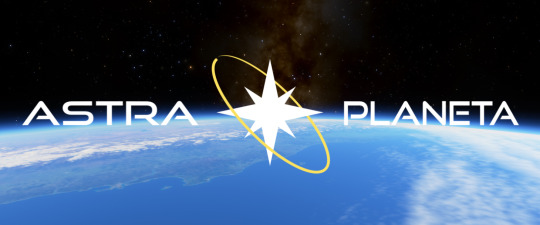
Gave the Astra Planeta overview article a HUGE rework. Like... 2000 words' worth of rework. Have a look!